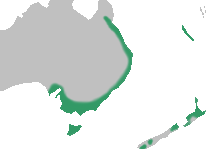Acianthus
| Acianthus | |
|---|---|
 | |
| Acianthus fornicatus | |
| Scientific classification | |
| Kingdom: | Plantae |
| (unranked): | Angiosperms |
| (unranked): | Monocots |
| Order: | Asparagales |
| Family: | Orchidaceae |
| Subfamily: | Orchidoideae |
| Tribe: | Diurideae |
| Subtribe: | Acianthinae |
| Genus: | Acianthus R.Br., 1810 |
| Species | |
|
See text. | |

Acianthus is a small genus of 9 known species, 8 endemic in Australia and 1 in New Zealand, from the orchid family (Orchidaceae). Acianthus was once circumscribed to include about twice as many species, but the additional species have now been redistributed to other genera, such as Acianthella.[1]
The name is derived from the Greek words achis (point) and anthos (flower), referring to the pointed sepals. Common Australian names include "Pixie-caps," "Gnat Orchid," and "Mosquito Orchid." Acianthus species occur in Australia and New Zealand, in small groups in forests on decaying litter, or occasionally on partially decayed logs or in association with bracken fern.
These terrestrial orchids have small, globular, subterranean tubers from which the flower stems arise. They form dense vegetative colonies, in sheltered forest or heathland, and are often found underneath shrubs and bracken. There is a single, heart-shaped, clasping leaf, often with purple markings, near the base, held horizontally above the soil. The flowers often resemble mosquitoes. These orchids produce a terminal raceme, arising from near the center of a solitary leaf, bearing pinkish or greenish flowers with a long spur. There are small flowers (4 to 5 mm), blending in with the surroundings. They are pollinated by small gnats seeking the nectar from the unlobed labellum.[1]
Species
- Acianthus apprimus Early Mosquito Orchid (NSW Blue Mountains to New England highlands).
- Acianthus borealis Northern Mosquito Orchid (Qld. Mt. Windsor Tableland to Blackdown Tableland).
- Acianthus collinus Inland Mosquito Orchid (NSW slopes of Great Darling Range between Taree and Crowther; ACT Black Mountains).
- Acianthus exiguus Tiny Mosquito Orchid (NSW Repton to Wardell).
- Acianthus exsertus Gnat orchid (E. & SE. Australia). (type species).
- Acianthus fornicatus Pixie-caps (E. Australia).
- Acianthus ledwardii Ledward's Mosquito Orchid (SE. Queensland) (Extinct).
- Acianthus pusillus Small Mosquito Orchid (Qld. n. to Eungella, NSW, Victoria, Tasmania).
- Acianthus sinclairii (New Zealand - incl. Stewart I.), Chatman Is., Kermadec Is.)
Former species
These species were formerly placed in Acianthus but have since been transferred to other genera.
- Acianthus amplexicaulis (NE. Queensland to EC. New South Wales, New Caledonia) - now classified as Acianthella amplexicaulis.
- Acianthus caudatus Mayfly orchid, dead-horse orchid (SE. Australia) - now classified as Nemacianthus caudatus.
- Acianthus huegelii - now classified as a variety, Cyrtostylis reniformis var. huegelii.
- Acianthus reniformis - now classified as Cyrtostylis reniformis.
- Acianthus sublestus (NE Queensland) - now classified as Acianthella sublesta
- Acianthus tenuissima - now classified as Cyrtostylis tenuissima.
Footnotes
External links
 Media related to Acianthus at Wikimedia Commons
Media related to Acianthus at Wikimedia Commons Data related to Acianthus at Wikispecies
Data related to Acianthus at Wikispecies- Photo of Acianthus fornicatus